Trichoderma reesei CRE1-mediated Carbon Catabolite Repression in Re-sponse to Sophorose Through RNA Sequencing Analysis
- PMID: 27226768
- PMCID: PMC4864841
- DOI: 10.2174/1389202917666151116212901
Trichoderma reesei CRE1-mediated Carbon Catabolite Repression in Re-sponse to Sophorose Through RNA Sequencing Analysis
Abstract
Carbon catabolite repression (CCR) mediated by CRE1 in Trichoderma reesei emerged as a mechanism by which the fungus could adapt to new environments. In the presence of readily available carbon sources such as glucose, the fungus activates this mechanism and inhibits the production of cellulolytic complex enzymes to avoid unnecessary energy expenditure. CCR has been well described for the growth of T. reesei in cellulose and glucose, however, little is known about this process when the carbon source is sophorose, one of the most potent inducers of cellulase production. Thus, we performed high-throughput RNA sequencing to better understand CCR during cellulase formation in the presence of sophorose, by comparing the mutant ∆cre1 with its parental strain, QM9414. Of the 9129 genes present in the genome of T. reesei, 184 were upregulated and 344 downregulated in the mutant strain ∆cre1 compared to QM9414. Genes belonging to the CAZy database, and those encoding transcription factors and transporters are among the gene classes that were repressed by CRE1 in the presence of sophorose; most were possible indirectly regulated by CRE1. We also observed that CRE1 activity is carbon-dependent. A recent study from our group showed that in cellulose, CRE1 repress different groups of genes when compared to sophorose. CCR differences between these carbon sources may be due to the release of cellodextrins in the cellulose polymer, resulting in different targets of CRE1 in both carbon sources. These results contribute to a better understanding of CRE1-mediated CCR in T. reesei when glucose comes from a potent inducer of cellulase production such as sophorose, which could prove useful in improving cellulase production by the biotechnology sector.
Keywords: CRE1; Carbon catabolite repression; RNA-seq; Sophorose; Trichoderma reesei.
Figures





Similar articles
-
New Genomic Approaches to Enhance Biomass Degradation by the Industrial Fungus Trichoderma reesei.Int J Genomics. 2018 Sep 24;2018:1974151. doi: 10.1155/2018/1974151. eCollection 2018. Int J Genomics. 2018. PMID: 30345291 Free PMC article. Review.
-
Defining the genome-wide role of CRE1 during carbon catabolite repression in Trichoderma reesei using RNA-Seq analysis.Fungal Genet Biol. 2014 Dec;73:93-103. doi: 10.1016/j.fgb.2014.10.009. Epub 2014 Oct 18. Fungal Genet Biol. 2014. PMID: 25459535
-
Redesigning transcription factor Cre1 for alleviating carbon catabolite repression in Trichoderma reesei.Synth Syst Biotechnol. 2020 Jul 15;5(3):230-235. doi: 10.1016/j.synbio.2020.07.002. eCollection 2020 Sep. Synth Syst Biotechnol. 2020. PMID: 32695894 Free PMC article.
-
Expression pattern of cellulolytic and xylanolytic genes regulated by transcriptional factors XYR1 and CRE1 are affected by carbon source in Trichoderma reesei.Gene Expr Patterns. 2014 Mar;14(2):88-95. doi: 10.1016/j.gep.2014.01.003. Epub 2014 Jan 27. Gene Expr Patterns. 2014. PMID: 24480777
-
Regulation of Trichoderma cellulase formation: lessons in molecular biology from an industrial fungus. A review.Acta Microbiol Immunol Hung. 2003;50(2-3):125-45. doi: 10.1556/AMicr.50.2003.2-3.3. Acta Microbiol Immunol Hung. 2003. PMID: 12894484 Review.
Cited by
-
The Duality of the MAPK Signaling Pathway in the Control of Metabolic Processes and Cellulase Production in Trichoderma reesei.Sci Rep. 2018 Oct 8;8(1):14931. doi: 10.1038/s41598-018-33383-1. Sci Rep. 2018. PMID: 30297963 Free PMC article.
-
Assessing the intracellular primary metabolic profile of Trichoderma reesei and Aspergillus niger grown on different carbon sources.Front Fungal Biol. 2022 Sep 27;3:998361. doi: 10.3389/ffunb.2022.998361. eCollection 2022. Front Fungal Biol. 2022. PMID: 37746225 Free PMC article.
-
Production of the versatile cellulase for cellulose bioconversion and cellulase inducer synthesis by genetic improvement of Trichoderma reesei.Biotechnol Biofuels. 2017 Nov 15;10:272. doi: 10.1186/s13068-017-0963-1. eCollection 2017. Biotechnol Biofuels. 2017. PMID: 29167702 Free PMC article.
-
Consolidated bioethanol production from olive mill waste: Wood-decay fungi from central Morocco as promising decomposition and fermentation biocatalysts.Biotechnol Rep (Amst). 2020 Oct 9;28:e00541. doi: 10.1016/j.btre.2020.e00541. eCollection 2020 Dec. Biotechnol Rep (Amst). 2020. PMID: 33102160 Free PMC article.
-
New Genomic Approaches to Enhance Biomass Degradation by the Industrial Fungus Trichoderma reesei.Int J Genomics. 2018 Sep 24;2018:1974151. doi: 10.1155/2018/1974151. eCollection 2018. Int J Genomics. 2018. PMID: 30345291 Free PMC article. Review.
References
-
- Seiboth B., Gamauf C., Pail M., Hartl L., Kubicek C.P. The D-xylose reductase of Hypocrea jecorina is the major aldose reductase in pentose and D-galactose catabolism and necessary for β-galactosidase and cellulase induction by lactose. Mol. Microbiol. 2007;66(4):890–900. doi: 10.1111/j.1365-2958.2007.05953.x. - DOI - PubMed
LinkOut - more resources
Full Text Sources
Other Literature Sources
Molecular Biology Databases
